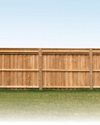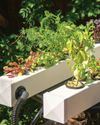Stylish seating, made from construction lumber!

If you think this bench looks sturdy, you’re right; it’s brawny enough to withstand decades of hard use. But if you think it’s complicated, take a close look at the following pages. You’ll see how simple it is to turn inexpensive framing lumber into graceful curves.
Create the legs
Start with flat, straight boards—free of splits, twists, cupping and loose knots— and you’ll spare yourself a lot of head-scratching and extra work down the road. I chose Douglas fir lumber, but any 1-1/2-in.-thick stock will do. If you have trouble finding perfect 2x12s for leg material, purchase extra lumber so you can cut around the defects.
To create a single bench, cut the four 22-in. leg blanks (A) to length; the ends need to be square, so cut carefully. Pair up your boards so when one is laid atop the other, there is little or no gap along the ends and edges. If you flip or rotate the boards, you might find the perfect fit. Try to have any defects fall in the areas of the wood you’ll be cutting away as you form the legs.
Build the legs
Mark out your leg template on 1/4-in. plywood as shown in Photo 1. Cut just outside the line with a fine-tooth jigsaw blade, then use a belt sander to sand right up to the line.
Use your template to mark the leg shape on all four leg parts (A). With the marks facing up, lightly dampen one board—polyurethane glue needs moisture to work—then apply the glue in squiggles across the main body of the leg. Use a putty knife to spread it slightly beyond the edges of your template marks. Polyurethane glue is waterproof, and with tightly glued seams there’s less chance of moisture working its way between the boards.
Denne historien er fra July - August 2019-utgaven av Family Handyman.
Start din 7-dagers gratis prøveperiode på Magzter GOLD for å få tilgang til tusenvis av utvalgte premiumhistorier og 9000+ magasiner og aviser.
Allerede abonnent ? Logg på
Denne historien er fra July - August 2019-utgaven av Family Handyman.
Start din 7-dagers gratis prøveperiode på Magzter GOLD for å få tilgang til tusenvis av utvalgte premiumhistorier og 9000+ magasiner og aviser.
Allerede abonnent? Logg på

7 Bicycle Maintenance Tips
Keep your bike in tiptop shape and ride safe!

SETTING FENCE POSTS WITH EXPANDING FOAM
Any fence builder knows you need strong posts for a strong fence, and that means backfilling the postholes with a dense, hard material other than dirt.

PEBBLE MOSAIC STEPPING STONES
COLLECT SOME RIVER ROCK AND MAKE YOUR OWN UNIQUE STEPPINGSTONE PATH

EARTH-FRIENDLY WEED KILLERS
HEALTHIER CHOICES FOR HUMANS AND THE ENVIRONMENT

DIY! HYDROPONIC GARDEN
FRESH VEGETABLES AT YOUR FINGERTIPS

GROW MINI VEGETABLES
GROW A GARDEN IN A TINY SPACE!

BUILD A VERTICAL GARDEN
TIME TO GROW UP!

MODERN WATER FOUNTAINS
A SPLASH OF PEACE FOR YOUR PATIO

9 ALTERNATIVE USES FOR SAWDUST
Every fully stocked wood shop has a table saw. You can usually find a pile of sawdust under it, even if it's used only occasionally. If a shop has a belt sander or band saw, there's probably another pile of finer sawdust under that. Even people without stationary tools have sawdust accumulation on their workbenches.

INSULATE WITH FOAM
IT'S A GREAT ALTERNATIVE TO FIBERGLASS